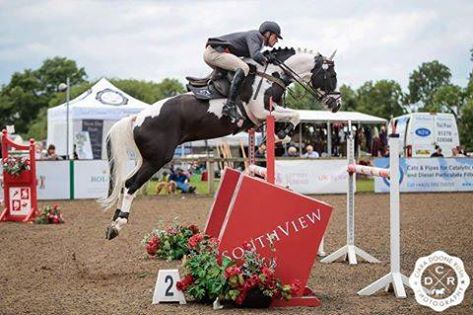Selle Francais Foal For Sale
The Selle Francais warmblood, referred to in France as Cheval de SelleFrançais, is becoming ever more popular in the show jumping and eventing worlds. In the Eventing world it is now considered the superior breed, best able to cope with the modern day demands of the sport. It is one of the more modern warmblood breeds. The name Cheval de Selle Francais ( French Saddle Horse ) was first used in 1958 and the Selle Francais studbook was started in 1965. The name was initially used to refer to half - bred warmblood sport horses that were not Anglo - Arabs.The breed`s evolution began in Normandy in the early 1700s, when Norman mares were crossed with English Thoroughbreds, English half - breds and the now defunct Norfolk Roadster. These crosses produced three distinct types - a draught animal, a riding horse and a fast harness horse - that evolved into the French Trotter. It was the Anglo - Norman riding horse, influenced by Thoroughbred and Norfolk Roadster blood that was the forerunner for the modern Selle Francais..
The most influential breed was the Anglo-Norman, developed in Normandy in the 19th century by crossing Norfolk Trotter, Thoroughbred, and Arabian stallions to refine the local mares (which themselves traced back to the medieval Norman war-horse). About 90 per cent of today`s Selle Français trace back to this breed. Other regional breeds used to influence the Selle Français were theCharolais, Corlay, Vendee, Anjou, Ain, and Ardennes.
A small number of Thoroughbred stallions influenced the breed. The first was Orange Peel who stood at the national stud from 1925 to 1940. His grandson, Ibrahim, also had a great influence on the Selle Français. Furioso, who is thought to be the most influential Thoroughbred in warmblood breeding, topped the sire list for 10 consecutive years , producing top show jumping horses. Lord Frey, Ivanhoe and Ultimate. Rantzau and Ultimate were also incredibly important in the Selle Français breed along with The names of these Thoroughbred sires can be found in virtually every successful modern Selle Français.
Unfortunately French stock was seriously reduced during the world wars, but breeding continued and the Selle Francaise has subsequently become renowned as a successful show jumping and eventing breed. It is now split into show jumping and racing types, the latter being slightly lighter in build. At the 2002 World Equestrian Games there were more Selle Francais horses competing than any other breed, winning five of the French team`s seven medals.
The average Selle Francais stands at least 16hh and chestnut is the predominant breed colour although it can be of any colour. The breed generally has broad quarters and strong hocks hence making it suitable for jumping but conformation varies due to its diverse ancestry.
Grading
The breed is not a traditional `breed` where breed type and the right blood lines are all important. To understand their success the horse lover must understand the grading. For mares and stallions alike, competition success and the success of offspring and other relatives all influence the grading of a horse.
The method of grading horses for breeding is very scientific. It has been devised over many years by the French National Stud Haras Nationaux and, unusually, is applied to both Stallions and Mares. The grading is broken into three distinct parts, judged by at least 2 judges per section.
1. Inspection of jumping ability (30% of marks). This includes
- Balance on the approach to a fence.
- Power and scope.
- Style.
- Mental approach.
3. Inspection of movement (30% of marks). This includes
- Trot
- Canter
- Walk
Well-known horses include
- Almé Z: foaled in 1966, this show jumper has contributed a great amount to the breed. He sired Galoubet A, Jalisco B, I Love You, Herban, Jolly Good, and others.
- Galoubet A: was foaled in 1972, and was champion French 5-year-old in 1977, and champion of France in 1979. He finished either first or second in 19 international Grand Prix show jumping events, and was on the French World Championship winning team in 1982 at Dublin. In 2002, he was the top money earning sire American-based sire of show jumpers. He sired two incredible, and very well-known, horses, Baloubet du Rouet and Quick Star. He also sired Irish bred Touchdown, who in turn sired 2002 World Equestrian Games Individual Gold medalist Liscalgot, in Show Jumping.
- Baloubet du Rouet: was foaled in 1989, and won the World Cup of Show Jumping an unprecedented three years in a row (1998-2000). He was a member of the bronze-winning team at the 2000 Sydney Olympic Games.
- I Love You: foaled in 1974, by Almé Z, he won the World Cup of Show Jumping at Vienna in 1983. That same year, he was named Horse of the Year in the United States, and has become an important sire of show jumpers.
- Jappeloup: Olympic Individual Gold medal winner Seoul 1988. Team Gold medal winner 1990 World Equestrian Games at Stockholm. 1986 World Championships 4th Individually.
- Quito de Baussy: foaled in 1982. Won six international medals in show jumping, including individual and team gold at the 1990 World Equestrian Games at Stockholm.
- Quidam de Revel: foaled in 1982, was a member of the bronze medal winning French team at the 1992 Barcelona Olympics, where he finished fourth individually. Recognized would-wide as a sire of show jumpers.
- Laudanum: foaled in 1967, was an approved French Thoroughbred stallion. In 2001, was named leading sire of show jumpers by USA Equestrian. Oh Star, ridden by Todd Minikus, is the son of this stallion.



